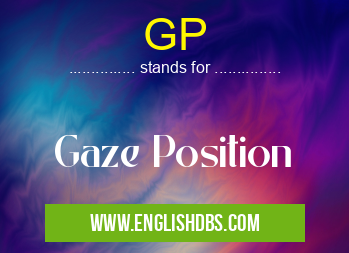What does GP mean in UNCLASSIFIED
GP (Gaze Position) is a term used in vision research and eye tracking to refer to the position of a person's gaze, or where they are looking. It is an important measure in understanding visual attention and cognitive processes, as it can provide insights into a person's interests, intentions, and thought patterns.

GP meaning in Unclassified in Miscellaneous
GP mostly used in an acronym Unclassified in Category Miscellaneous that means Gaze Position
Shorthand: GP,
Full Form: Gaze Position
For more information of "Gaze Position", see the section below.
Measuring Gaze Position
GP is typically measured using eye tracking technology, which involves using cameras to record the movement of a person's eyes. This technology can provide precise measurements of the point of gaze, allowing researchers to determine what a person is looking at and for how long.
Applications of GP
GP has various applications in research and practical fields, including:
- Cognitive Psychology: Studying visual attention, memory, and decision-making.
- Human-Computer Interaction: Designing user interfaces and understanding user behavior.
- Marketing and Advertising: Analyzing the effectiveness of visual stimuli in capturing attention.
- Medical Research: Assessing eye movement abnormalities in conditions such as Parkinson's disease and autism spectrum disorder.
Benefits of Using GP
- Objective and Real-Time: Provides objective and real-time data on eye movements, reducing the reliance on self-reporting.
- Non-Invasive: Eye tracking is a non-invasive technique, making it suitable for use with a wide range of participants.
- Versatile: GP can be used in various research settings, including laboratory experiments and naturalistic observations.
Essential Questions and Answers on Gaze Position in "MISCELLANEOUS»UNFILED"
What is Gaze Position (GP)?
Gaze Position (GP) refers to the direction of a person's gaze, which indicates where they are visually attending. It is a key component in understanding cognitive processes, such as attention, perception, and decision-making.
How is Gaze Position measured?
Gaze Position can be measured using various techniques, including:
- Eye-tracking devices: These devices use sensors to track the movement of the eyes and determine the direction of gaze.
- Head-mounted cameras: Cameras mounted on a headset can capture the direction of the wearer's gaze.
- Behavioral observations: Observers can manually record the direction of gaze based on a person's head and eye movements.
What are the applications of Gaze Position data?
Gaze Position data has numerous applications, including:
- Cognitive research: Studying attention, perception, decision-making, and other cognitive processes.
- Human-computer interaction: Designing user interfaces that are more intuitive and user-friendly.
- Marketing research: Understanding how consumers visually engage with products and advertisements.
- Medical diagnostics: Detecting neurological and developmental disorders that affect eye movements.
What factors can affect Gaze Position?
Gaze Position can be influenced by various factors, such as:
- Attention: The direction of gaze is often drawn to objects or areas that are currently being attended to.
- Motivation: Goals and desires can influence where a person looks.
- Context: The surrounding environment and social interactions can affect Gaze Position.
- Cognitive processes: Gaze Position is also associated with higher-level cognitive processes, such as working memory and decision-making.
How can Gaze Position be used to improve communication?
By understanding Gaze Position, we can gain insights into a person's thoughts and intentions. This information can be used to improve communication by:
- Making eye contact: Intentional eye contact helps establish rapport and build trust.
- Interpreting nonverbal cues: Gaze patterns can reveal emotions, beliefs, and interests.
- Understanding social interactions: Gaze Position provides clues about the dynamics between individuals.
Final Words: GP is a valuable tool for understanding visual attention and cognitive processes. Its precise measurements and versatile applications make it a powerful tool in various fields of research and practical use. By analyzing GP, researchers and practitioners can gain valuable insights into human behavior, design more effective user experiences, and advance our understanding of the human mind.
GP also stands for: |
|
| All stands for GP |
